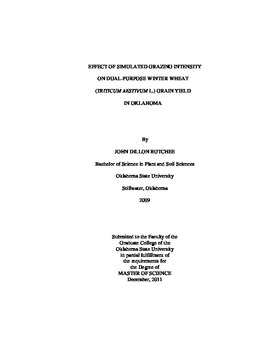| dc.contributor.advisor | Edwards, Jeffrey T. | |
| dc.contributor.author | Butchee, John Dillon | |
| dc.date.accessioned | 2014-04-15T22:05:53Z | |
| dc.date.available | 2014-04-15T22:05:53Z | |
| dc.date.issued | 2011-12-01 | |
| dc.identifier.uri | https://hdl.handle.net/11244/9308 | |
| dc.description.abstract | Dual-purpose winter wheat growth and grain yield are influenced by cattle stocking density and variety selection. The objectives of this study were to determine the effect of mowing height on winter wheat grain yield, determine which growth habit has the least negative yield response to grazing, and determine the potential to use NDVI as a means of monitoring crop canopy closure. Grazing intensity was simulated at Stillwater and Lahoma, OK by mowing wheat to heights of 3, 7.5, and 12 cm at approximately four-week intervals. Mowing was initiated in early November and terminated at first hollow stem in the spring. Canopy closure was obtained using digital photography, and NDVI was measured with a handheld sensor. Canopy closure and NDVI measured throughout the grazing season were positively correlated with mowing height. Regression analysis determined NDVI could be used as a substitute for canopy closure when determining the impact of grazing on wheat growth (R2=0.93). Relative grain yield had an asymptotic response to canopy closure and NDVI measurements taken prior to winter dormancy and at grazing termination. The 3-cm mowing height reduced grain yield of Fuller by 26%, but reduced grain yield of Overley by 39%, compared with the non-defoliated treatments. The results of this study indicate that there is a grain yield loss associated with grazing wheat, yield loss is greater at high grazing intensities, and grain yield of Fuller was not as negatively impacted by grazing as compared to Overley due to the effect of growth habit.</ | |
| dc.format | application/pdf | |
| dc.language | en_US | |
| dc.publisher | Oklahoma State University | |
| dc.rights | Copyright is held by the author who has granted the Oklahoma State University Library the non-exclusive right to share this material in its institutional repository. Contact Digital Library Services at lib-dls@okstate.edu or 405-744-9161 for the permission policy on the use, reproduction or distribution of this material. | |
| dc.title | Effect of Simulated Grazing Intensity on Dual Purpose Winter Wheat (Triticum Aestivum L.) Grain Yield in Oklahoma | |
| dc.type | text | |
| dc.contributor.committeeMember | Redfearn, Daren D. | |
| dc.contributor.committeeMember | Carver, Brett F. | |
| osu.filename | Butchee_okstate_0664M_11733.pdf | |
| osu.college | Agricultural Sciences and Natural Resources | |
| osu.accesstype | Open Access | |
| dc.description.department | Department of Plant and Soil Sciences | |
| dc.type.genre | Thesis | |
| dc.subject.keywords | opy closure | |
| dc.subject.keywords | dual-purpose | |
| dc.subject.keywords | grazing | |
| dc.subject.keywords | insolation | |
| dc.subject.keywords | triticum aestivum | |
| dc.subject.keywords | wheat | |
